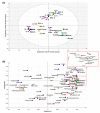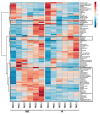Dynamics of Short-Term Metabolic Profiling in Radish Sprouts (Raphanus sativus L.) in Response to Nitrogen Deficiency
- PMID: 31547524
- PMCID: PMC6843509
- DOI: 10.3390/plants8100361
Dynamics of Short-Term Metabolic Profiling in Radish Sprouts (Raphanus sativus L.) in Response to Nitrogen Deficiency
Abstract
Nitrogen (N) is a macronutrient important for the survival of plants. To investigate the effects of N deficiency, a time-course metabolic profiling of radish sprouts was performed. A total of 81 metabolites-including organic acids, inorganic acid, amino acids, sugars, sugar alcohols, amines, amide, sugar phosphates, policosanols, tocopherols, phytosterols, carotenoids, chlorophylls, and glucosinolates-were characterized. Principal component analysis and heat map showed distinction between samples grown under different N conditions, as well as with time. Using PathVisio, metabolic shift in biosynthetic pathways was visualized using the metabolite data obtained for 7 days. The amino acids associated with glucosinolates accumulated as an immediate response against -N condition. The synthesis of pigments and glucosinolates was decreased, but monosaccharides and γ-tocopherol were increased as antioxidants in radish sprouts grown in -N condition. These results indicate that in radish sprouts, response to N deficiency occurred quickly and dynamically. Thus, this metabolic phenotype reveals that radish responds quickly to N deficiency by increasing the content of soluble sugars and γ-tocopherol, which acts as a defense mechanism after the germination of radish seeds.
Keywords: metabolic profiling; nitrogen; nitrogen deficiency; nitrogen metabolism; radish sprouts.
Conflict of interest statement
The authors declare no conflict of interest.
Figures




Similar articles
-
Comparative analysis of phytochemicals and antioxidant activities in seeds and sprouts of different varieties of radish (Raphanus sativus L.): TOPSIS-entropy weight method.Front Plant Sci. 2025 Feb 7;16:1531570. doi: 10.3389/fpls.2025.1531570. eCollection 2025. Front Plant Sci. 2025. PMID: 39990715 Free PMC article.
-
The primary active components, antioxidant properties, and differential metabolite profiles of radish sprouts (Raphanus sativus L.) upon domestic storage: analysis of nutritional quality.J Sci Food Agric. 2018 Dec;98(15):5853-5860. doi: 10.1002/jsfa.9137. Epub 2018 Jul 4. J Sci Food Agric. 2018. PMID: 29786832
-
Effects of sulfur fertilization on the accumulation of health-promoting phytochemicals in radish sprouts.J Agric Food Chem. 2013 Aug 7;61(31):7552-9. doi: 10.1021/jf402174f. Epub 2013 Jul 25. J Agric Food Chem. 2013. PMID: 23855586
-
Phytochemical composition and biological activity of 8 varieties of radish (Raphanus sativus L.) sprouts and mature taproots.J Food Sci. 2011 Jan-Feb;76(1):C185-92. doi: 10.1111/j.1750-3841.2010.01972.x. J Food Sci. 2011. PMID: 21535648
-
Raphanus sativus L. var niger as a source of phytochemicals for the prevention of cholesterol gallstones.Phytother Res. 2014 Feb;28(2):167-71. doi: 10.1002/ptr.4964. Epub 2013 Mar 15. Phytother Res. 2014. PMID: 23495001 Review.
Cited by
-
Special Issue Editorial: Plant Nitrogen Assimilation and Metabolism.Plants (Basel). 2021 Jun 23;10(7):1278. doi: 10.3390/plants10071278. Plants (Basel). 2021. PMID: 34201753 Free PMC article.
-
Silencing of the Target of Rapamycin Complex Genes Stimulates Tomato Fruit Ripening.Mol Cells. 2022 Sep 30;45(9):660-672. doi: 10.14348/molcells.2022.2025. Epub 2022 Aug 22. Mol Cells. 2022. PMID: 35993163 Free PMC article.
-
Metabolite Changes in Soybean (Glycine max) Leaves during the Entire Growth Period.ACS Omega. 2023 Oct 24;8(44):41718-41727. doi: 10.1021/acsomega.3c06043. eCollection 2023 Nov 7. ACS Omega. 2023. PMID: 37969993 Free PMC article.
-
Multivariate Analysis of Amino Acids and Health Beneficial Properties of Cantaloupe Varieties Grown in Six Locations in the United States.Plants (Basel). 2020 Aug 19;9(9):1058. doi: 10.3390/plants9091058. Plants (Basel). 2020. PMID: 32824999 Free PMC article.
References
-
- Kim Y.-N., Giraud D.W., Driskell J.A. Tocopherol and carotenoid contents of selected Korean fruits and vegetables. J. Food Compos. Anal. 2007;20:458–465. doi: 10.1016/j.jfca.2007.02.001. - DOI
-
- Jing P., Zhao S.-J., Ruan S.-Y., Xie Z.-H., Dong Y., Yu L. Anthocyanin and glucosinolate occurrences in the roots of Chinese red radish (Raphanus sativus L.), and their stability to heat and pH. Food Chem. 2012;133:1569–1576. doi: 10.1016/j.foodchem.2012.02.051. - DOI
LinkOut - more resources
Full Text Sources

